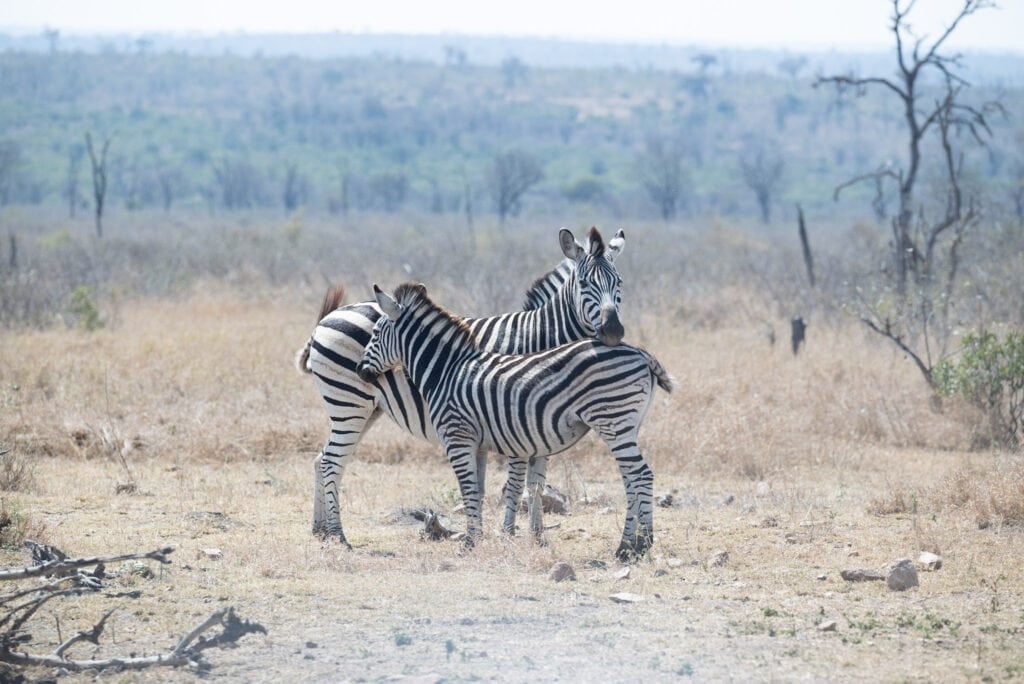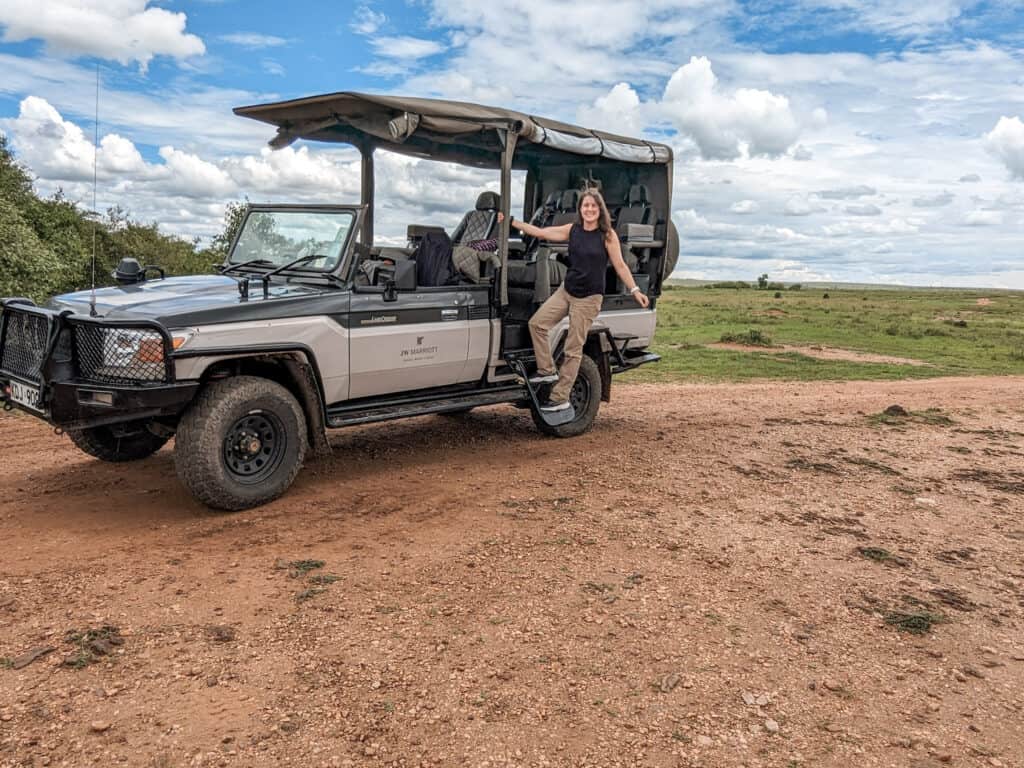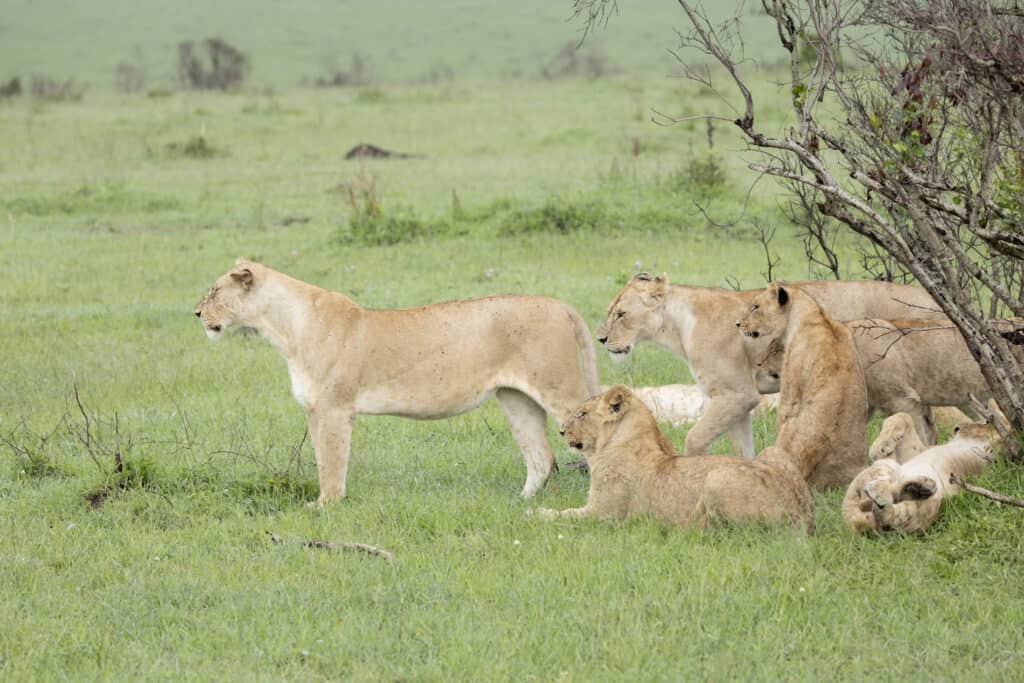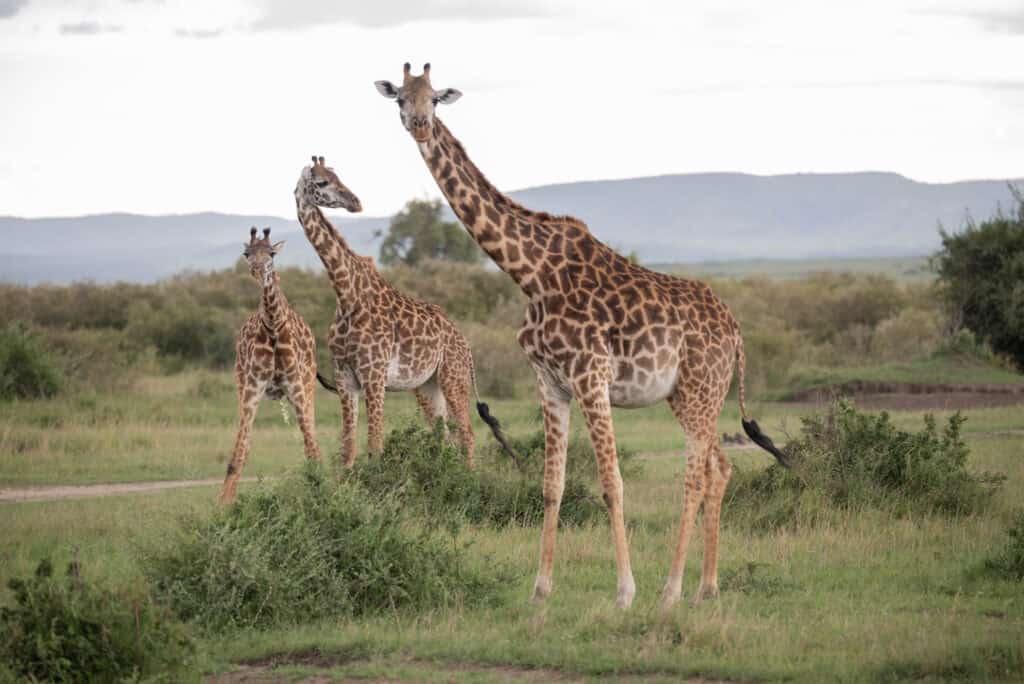Your First Safari: 9 Tips for A Great Time
An African safari is a bucket list trip, and it’s unlike any other trip you’ve been on. Knowing what to expect can be tough. I’ve been on four different safaris in three different countries, stayed in luxury properties in Kenya, and camped in Botswana. There are 9 ways to ensure you have an incredible first safari experience no matter where you’re staying!
Some of the links on the page are affiliate links. If you choose to purchase from one of the links, I earn money at no extra cost to you. I’ll only recommend brands I’ve used and love (or an alternative I would book myself). As an Amazon Associate, I earn from qualifying purchases. I always pay for my own travel. I’ll be sure to let you know if that ever changes. If you choose to click through and purchase – thanks so much for the support!
1- Know What Season You’re Visiting In
You’ll have a great experience no matter what, but the season of your game drive determines so much, from what you should pack to what you should expect to see. Think about what you want out of your safari and how to set yourself up for success by going in the right season.
The dry season can mean hotter temperatures. It also means most of the foliage is dried up and dead. So, it’s easier to spot animals through the bush, and they will likely congregate near watering holes more frequently.

The rainy season means you’re likely to get rained on at some point during your trip, so pack a rain jacket. But the foliage is green, and the landscapes are beautiful. I also had much more success seeing baby animals during the rainy season and no problems spotting wildlife on my trip.
The rainy season usually means slightly cheaper prices because it’s the off-season. But you’ll still see animals, so it’s okay to take advantage of a deal!

The Great Migration is a massive herd of wildebeest and zebra that travel between the Serengeti in Tanzania and the Masai Mara in Kenya. The animals do what they want, but the Great Migration is common in Kenya from July through October and in Serengeti the rest of the year.
The Great Migration is a lot of herd animals. But if you’re not looking to watch a kill live in your very own NatGeo moment, this may not be the best pick for you. It’s most common to see kills in action during this time. The increase in grazing animals leads to an increase in activity.
I cried after I watched my first kill, and I’m not sure it’s something I’ll go out of my way to try to see again. There’s no shame in wanting to see animals and avoid this part of nature if possible. You do you.
What I’ve Packed on Safari – A Quick List
- Exofficio underwear– my go-to for travel anyway, but a must for a safari
- She-wee for the ladies
- A camera set up if you want good pictures- I take my Nikon Z5 and a 100-400 mm lens.
- Binoculars are an absolute must. Borrow from a friend if you can, but I use them when we travel anywhere with animals.
- Sunscreen
- Sunglasses and or a hat. I don’t wear hats, so my Goodr sunglasses are a must.
- Medications
- Comfortable layers – Prana Pants and flowy tops are my go-tos
- Some snacks for long safari days
- Visas and local currency
2- Pack Lightweight Clothing
Pack layers and lightweight clothes. Even with chilly mornings and evenings, the days can still be very hot. Layers help you be prepared for whatever the weather throws your way.
Before my first safari, I asked a friend if I actually needed the full-on safari gear you see in so many photos. Her answer was a “please, no. The locals don’t wear that, and you don’t need to.”
So, wear what you want.
I pack a variety of shorts, lightweight pants, and tank tops. Plus, fleece or flannel long sleeves. Cotton and linen served me well. A moisture-wicking fabric would probably do well, too.
Most of the time, you’re in a safari vehicle. So, while ultra-bright colors might stand out, so does the safari vehicle. I’ve seen people wear everything from leopard print to basketball shorts on safari. Ultra bright colors aren’t common but it’s not unheard of either.

It’s another you do you thing.
That said, the safari browns and greens photograph really well. But most of the time, you are photographing animals, not yourself.
Pack clothes that you can layer and that are comfortable when you’re sitting in for long periods. You spend so much time sitting in the back of a safari vehicle. This makes sense, but it wasn’t something I had expected when I was planning the first time around.
One Note: If you’re going on any kind of walking safari, you’ll want to wear dark clothing. The walking safaris in Kruger National Park specify this. Black and dark blue are common. White and other light colors won’t work. Most people wore black or grey sweatpants and sweatshirts.
3- Understand the Schedule of A Game Drive Day
The goal of a game drive is to see animals. Most predators, like the lions, are most active in the early morning and the evening just before sunset. You can’t drive around game parks at night, so these are the best times to see the animals.
Expect to wake up early and be out on your first game drive just as the sun rises. You may get tea or a small breakfast before. The mornings can be quite chilly, so your layers will be helpful.
The morning game drive lasts until it starts getting warm. Then, you’ll have breakfast or brunch, depending on your schedule. Then it’s time for some afternoon rest time. Take a nap or a shower, or spend time at the property you’re visiting.

You may eat lunch before you leave for your afternoon game drive, which will start when the day begins to cool. Since you aren’t allowed to drive after dark, the guides will start to bring you back to your property after dark, and you’ll have dinner.
It’s a very structured day, and it helps to have some snacks with you in case you get hungry during a long drive. You game drive operation may include snacks as well.
Some properties have full-day game drive options. It’s the same early morning and late night. But they’ll pack a lunch for you to eat in the vehicle or at one of the designated locations where you can leave the vehicle.
This allows you to get away from your property. But the guides know best if it’s worth it to take a full-day drive.
4- Get Your Vaccines and Bring Medication
Check the guidelines for information about vaccines you need to consider when traveling and whether you need malaria medication. If you’re from the US, this is where I look.
After you do your research, talk to your doctor or a travel doctor for advice.
I’m not a doctor, so I won’t advise you on what you should and shouldn’t do. I advise that you look and talk to your people to make decisions based on where you’re traveling.
This can take time. So, start early (like several months in advance).
As a celiac traveler, I always travel with medication, but I know most people don’t make a habit of that. On an African safari, you’re often quite far out in the bush to get to where the animals are.
Pack Advil, Tylenol, band-aids, and any daily medications you need.
I’d also recommend an over-the-counter anti-diarrheal. I won’t go on a trip without it.
It’s not something any of us like to talk about, but it’s not unusual for your stomach to bother you. Food is delicious but different, and travel makes our stomachs go wild. It’s a common side effect of the malaria meds you may be taking. But check with your doctor before you take anything.
5- Know What Currency and How Much To Bring
Your tour and hotels can often help with this part.
But first, you must know what currency is used. Sometimes, it’s straightforward, and sometimes, not so much.
For example, Zimbabwe has its own currency, but most business near Victoria Falls is actually done in US dollars. Even the ATMs dispense US Dollars.

Do some quick research or ask your booking contacts about what you need.
It’s also not uncommon for ATMs to be out of money on Mondays until they can restock. Do some research about your location to know what to expect.
Know what is included in your tour or with your properties. This can help you understand how much cash to bring with you.
You can get money changed at a bank before you leave. This can take several days, so allow some time.
For any trip, have a credit card with no foreign transaction fees.
It’s not a bad idea to have a debit card with no foreign transaction fees, too.
6- Have a Bathroom Plan
Again, not something we all love to talk about. But, have a plan. It’s likely you’ll need to use the bathroom at some point on a game drive.
The guides will typically have toilet paper but it doesn’t hurt to pack some for yourself.
Ladies, something like this can be helpful if you don’t enjoy using the restroom outside. I like that the one I linked is disposable (so you don’t have to deal with cleaning it).
I personally love my ExOfficio underwear for trips like this. They’re antimicrobial, wash super easily, and dry very fast.
7- Have The Right Photography Gear
Safari photos are some of the best souvenirs. Looking back through the memories of the incredible animals you saw will be something that brings joy for years after your trip.
You may get fairly close to some animals. But, if good photos matter to you, you’ll need more than a phone camera.
The ideal plan would be to take a camera with interchangeable lenses and a lens like 70 – 200 mm.
I take my Nikon Z5 (several years old) and my Nikon Nikkor 70 mm-200mm. It can be an expensive setup.
You can also rent camera gear if you don’t want to own it.
At the JW Marriott one of the perk is that you can check out a Canon EOS 6R Mark II and 100-500 mm lens (when I went). This Canon camera and lens set is pricey but it was the easiest camera. My husband, who doesn’t do photography, got amazing photos with it.
Taking great pictures requires some skills in photography and editing. Photo composition and light are important. You don’t need to know everything, but the basics will serve you well.
If you don’t want to put in the time, go with binoculars and your cell phone camera and hope someone in your group shares photos. I’ve even had some success with a cell phone camera looking through a binocular lens. It’s a weird way to do it, but it worked!
8- Be Flexible, Relax, Have fun!
Animals are unpredictable. So, your trip will be a bit unpredictable.
I remember wondering if we’d see animals. I truly had moments before my first safari where I thought I wouldn’t see anything.
Looking back, that was such a silly thing to worry about.
You will see animals.
But please don’t go with a list of animals you must see to consider it a good trip.
I’ve heard from so many safari guides that the people who come in with only one animal they want to see are the ones who really struggle to have a good time.
Go in prepared to be excited by whatever happens to come your way.
Cheetahs, lions, leopards, and the rest of the Big Five are incredible. But so are giraffes, hyenas, jackals, and zebras.

Go into this experience ready to be flexible, soak in what you can, and enjoy your time in a beautiful part of the world.
It will be a trip you will remember forever. Don’t spoil it by putting unnecessary stress on it.
9 – Plan Well in Advance
Safaris are bucket list trips. So, properties can be booked up quickly, and flights can be hard to find if you wait too long. So, start early. This gives you time to ask questions and look for what you want.
Look at several options for safaris. The main parks are popular for a reason. But one of my favorite safaris was camping in Botswana. Botswana wasn’t on my radar, and camping certainly wasn’t. But it was an incredible trip that hooked me on safaris.
Think about what you like, what you want to see, and your budget. Then, spend time looking for what meets all of your standards.
You can plan at the last minute, especially in the off-season, but you may not get to be as thoughtful as you want to be. On a bucket list trip like this, it’s worth some extra planning time.
Don’t forget to get your visas if you need them, and make sure your passport is valid.
Enjoy Your First Safari
If you travel much you’ve been asked what your favorite trip was. It’s always hard to answer. But, it gets much easier after a safari. It will be incredible.
They are my favorite trips by far.
I hope you have a great first safari. Let me know where you’re going and how it goes!